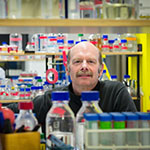Potential applications of CRISPR-Cas
CRISPR-Cas is a technique that allows the quick and easy alteration of genes. This technique has undergone a rapid development. This leads to the question: what do we want to achieve with CRISPR-Cas?
CRISPR-Cas was developed after microbiologists were amazed when they found pieces of repeating hereditary material in micro-organisms. John van der Oost’s research group from Wageningen University & Research also discovered this unique type of DNA fragments. In 2005, French and Spanish colleagues theorised that these DNA fragments could be a defence mechanism against viruses. This hypothesis was proven in the United States of America shortly afterwards. In 2008, van der Oost and his colleagues were the first to discover important details on how the E. coli bacteria’s ingenious self-defence mechanism works.
Protein scissors, a natural defence mechanism
The DNA scissors they discovered is a great example of an ingenious natural defence mechanism. The E. coli bacteria’s defence mechanism is able to recognise and disarm the DNA of viruses that invade the bacterium by cutting it. CRIPSR-Cas is known as the cutting mechanism.
Read all about the discovery, developments and applications in our Quick and simple gene repairs long read (9 minutes reading time).
The work of the WUR group inspired other f researches to explore the mechanism of the CRISPR-Cas system and variants thereof. This led to the discovery of a class of simple scissors – CRISPR-Cas9 – that have been revealed able to modify DNA-strands in many different kinds of organisms, including micro-organisms, plants, animals and people. This tool not only destroys genes, but can also be used to modify, repair or even introduce new genes in DNA-strands.
In 2015, the genetic toolbox was expanded further with the discovery of a second bacterial defence mechanism by Professor van der Oost of Wageningen University & Research’s Bacterial Genetics research group. CRISPR-Cpf1. The technique is being refined further with research happening across the globe.
CRISPR-Cas
The applications of the technique appear to be limitless at present, below is an overview of the possibilities in plants, animals and even humans.
- Plants can be adapted to bring about the following changes: altering resistance to diseases that we cannot control at present and increasing or decreasing their capacity to produce certain substances. As an example, mushrooms could even be adapted to prevent them from turning brown.
- The changes we could make to animal DNA could have profound results. By altering the DNA of pigs, we could make their organs better suited to transplant into humans. We could alter animals’ DNA to make them resistant to certain diseases or even prevent them from spreading diseases such as malaria or the Zika virus. We could potentially even alter the rate at which animals develop and grow.
- The potential applications for humans are very interesting as well. We could adapt human embryos and develop gene therapies for people with hereditary diseases such as Duchenne muscular dystrophy or cystic fibrosis.
“It is time to define which things we want to do and which things we certainly do not want to do with CRISPR-Cas”
Moral dilemmas surrounding gene technology
With all these potential applications, questions arise as to whether all applications would be equally desirable. It is currently forbidden to genetically alter an embryo and transfer it to the uterus. If that changes and such measures are used in the future, they must be guaranteed to succeed, explains van der Oost. ‘The CRISPR techniques are still being developed, but we already need to define which things we want to do with this and which things we certainly do not want to do.’ We definitely will want to use it to treat people’s genetic conditions, reduce pollution and improve food security. Especially within humans, we would only want to modify DNA if the results are very precise and do not damage other bits of our DNA.
What do you think? What are the boundaries of modifying DNA?
Leave your comment below or ask the researcher.
Attend the symposium CRISPR-Cas
On 8 March we will host the CRISPR-Cas – from evolution to revolution symposium in Wageningen. Four speakers – including Van de Oost – will discuss aspects of CRISPR-Cas: how it was developed, how the mechanism works, gene therapy and the ethical considerations. The symposium is intended for a broad audience and can be watched on the internet (only live) for free. We will also host the What is Life? science week from 12 to 14 March to complement the symposium and to celebrate the centenary of Wageningen University & Research.
Further reading
- WUR dossier on CRISPR-Cas
- Long read on quick and simple gene repairs
- This article explains how a team of students from Wageningen University was awarded the best team of the Topsector Chemie student competition for developing a cheap and simple sensor that can detect genetically modified bioweapons
- Dutch version of this blog: De mogelijkheden van CRISPR-Cas



Is there a calendar of events that WUR has undertaken with regard to CRISPR-Cas9 debates or dialogues. About the efforts made by the university in reaching the public?